About me and why I created this physics website.
Solar Energy
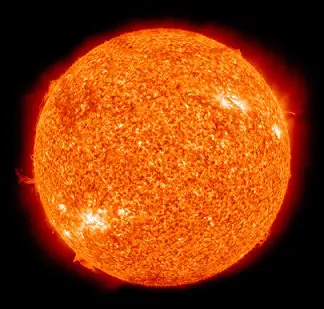
Source: http://en.wikipedia.org/wiki/Sun
Out of all the renewable energy options that are available, solar energy is the most plentiful. It's an energy source that comes directly from the sun. Energy from the sun reaches the earth by way of electromagnetic radiation. The sun, with its tremendous power output, can easily supply humanity with all the energy it needs and will ever need. There are different technologies available to tap into solar energy, some you will have heard of, and some you may not have heard of. In this newsletter I will summarize the main ways in which energy from the sun can be extracted.
Photovoltaics
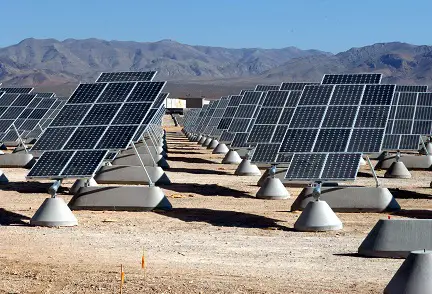
Source: http://en.wikipedia.org/wiki/Photovoltaic
Solar panels utilize the “photovoltaic effect” to produce electricity. The sun’s photons excites the electrons in the photosensitive panel material to produce electricity. Solar panels are valuable in many applications since they are a consistent source of power; which is true as long as there is regular daylight intervals (which is true almost everywhere). The only potential drawback is the cost. But if budget is not an issue and you want steady reliable power from one single renewable energy source that is almost entirely independent of geographic location, then solar panels are for you.
Photovoltaics (solar panels) can generate electricity year round but their output can vary depending on if it is sunny or cloudy. The output efficiency of the most efficient (silicon-based) commercially available solar panels is 15-20%, meaning that 15-20% of the solar energy that reaches the solar panel is converted into electricity. Furthermore, their cost is somewhat high, around $5-6/watt if you’re looking at a home installation. The cost per watt tends to be lower for large utility-scale installations.
An alternative to silicon-based solar panels is Thin-Film solar panels, which are less expensive to produce. However, they typically have an efficiency of about 10%, which is lower than silicon-based panels.
A further advantage of solar panels is that they require little maintenance once they are installed. There are no moving parts. All that is required is to keep the surface clean so that sunlight can get through.
For most homeowners, the best option is to install some solar panels to help reduce their electricity bill, instead of trying to live completely “off the grid” (since the cost to do this would be prohibitive).
Solar Thermal Energy
This source of power is most suitable in areas where there is little cloud cover year round. It relies on the unimpeded intensity of the sun, just like a magnifying glass will only focus sunlight when there are no clouds blocking the sun. The energy efficiency achieved by solar thermal can be twice that of photovoltaics.
Solar collectors are a common device used to capture the sun’s thermal energy. There are two main types. The first type is a flat-plate solar collector. These are collectors with a clear glass plate on top to help “trap” the sun’s heat, much like a “greenhouse” effect. This causes the interior of the collector to heat up. On the interior of the collector there is tubing which is painted black in order to better absorb the sun’s heat energy. This, combined with the “greenhouse” effect, will result in the tube temperature reaching 80-90 degrees Celsius.
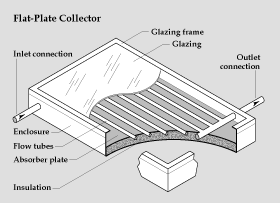
Source: Department Of Energy – Office Of Energy Efficiency And Renewable Energy (http://www.eere.energy.gov)
Inside the tubes there flows a coolant that heats up and then flows out of the collector and exchanges heat with another device, such as a water heater (solar water heating), which helps reduce water heating costs. Solar generated heat can also be used for space heating, reducing costs there as well.
Flat-plate solar collectors can also be “evacuated”. A vacuum is created between the collector tubes and an outer glass tube. This allows the collector temperature to become even hotter, over 100 degrees Celsius. The reason it gets hotter is because, in the absence of air, there is no heat loss due to convection, which is basically the transfer of heat to the glass tube, with air as the transfer path. With this heat loss medium removed, the collector heats up more.
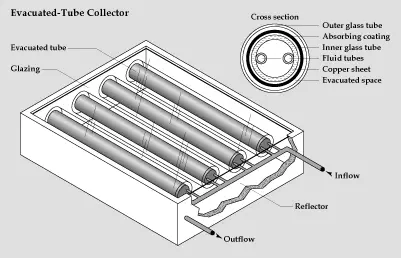
Source: Department Of Energy – Office Of Energy Efficiency And Renewable Energy (http://www.eere.energy.gov)
Solar collectors are among the least expensive of all solar installations, costing only a few thousand dollars for a typical home installation.
The other way to collect the sun’s thermal energy is by focusing the sun’s energy on to a small area, much like a magnifying glass, resulting in localized very high heat. This high heat can be utilized for electricity generation.
One application for concentrated solar heat is in “power towers”. Using many heliostats (mirrors), the sun is focused onto a central tower using tracking mechanisms. The power tower receives this concentrated energy to heat up water and run a steam turbine to generate electricity. Heat from the power tower is initially stored in a salt compound which becomes liquid at high temperature, and its heat is then used to turn water into steam in order to run a steam turbine. Because of the ability of salt to act as an efficient thermal storage at high temperature and low pressure, it can be easily transported through piping and into a storage tank for subsequent use in the steam power generator. It can store sufficient heat energy to provide electricity generation well into the night, after the sun goes down.
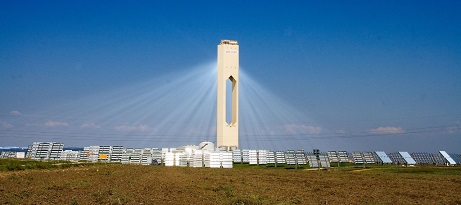
Source: http://en.wikipedia.org/wiki/PS10_solar_power_tower
The efficiency of a power tower can be around 20%, which means that 20% of the sun’s energy falling on the mirrors can be converted into electricity. Efficiency as high as 25% can be achieved with larger installations. Efficiency is somewhat proportional to the size of the installation.
Another means to utilize the sun’s thermal energy is with a solar concentrator, such as a parabolic dish. The figure below shows a SunCatcher system, in which a Stirling engine is placed near the focal point of a large parabolic dish, around 11 m in diameter. The dish is pointed directly at the sun using a tracking mechanism. This allows the sun’s energy to be focused onto a receiver placed at the focal point of the dish. This receiver channels the heat energy into the Stirling engine which generates electricity using an electric generator.
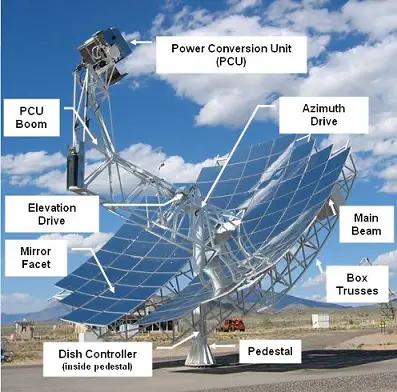
Source: http://www.stirlingenergy.com
The Stirling engine is unique among engines in that all it needs to run is a hot and cold source. In this case the hot source is the sun’s heat and the cold source is the ambient air. The concentrated heat energy of the sun hitting the receiver can be as much as 800 degrees Celsius! The higher the temperature, the more efficient a Stirling engine will be, due to the thermodynamics principle known as Carnot efficiency. In the SunCatcher, the efficiency is around 30%, which means that 30% of the energy that reaches the parabolic dish is converted into electricity by the Stirling engine. This is the highest efficiency of any device that converts solar energy into electricity. It is comparable to coal generating stations which can operate with an efficiency of 35-40%. Each SunCatcher can generate an average of 25 kW of power. That is enough power for a dozen homes.
The SunCatcher is ideal for scalability in that it is modular, meaning that to get more power you simply add more units. This type of scalability is not as easy to implement for a power tower.
Areas such as the southwestern United States are ideal for solar thermal energy. Any areas that have ample sun and little cloud cover year round, are suitable. The outdoor temperature does not have to be hot year round. As long as the sun is shining the receiver can reach a high temperature. In fact, the efficiency record for a SunCatcher was set on a cold and sunny winter day. This is because the cold “source” temperature, which is the ambient air, is colder than in summer months. And since the efficiency of a Stirling engine increases with increasing temperature difference between the hot and cold source, it resulted in a higher than normal power output.
The disadvantage of a SunCatcher power plant is that it can only output power during the day. There is no overnight storage capacity as is the case with a power tower. However, it is still valuable as it can help reduce grid load by offsetting some of the peak power use which is generally during the day.
If you're curious about Stirling engines and want to learn more about them go here.
Return to Physics Essays page
Return to Real World Physics Problems home page